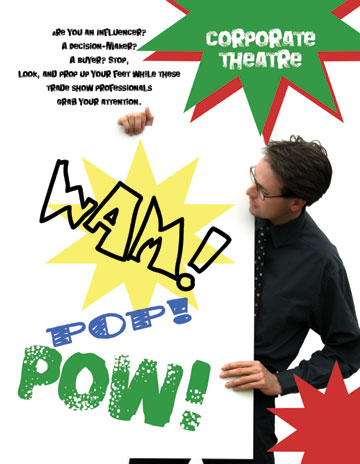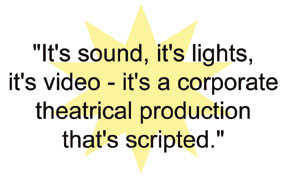
Corporate Theatre
Are you an Influencer?
A Decision-maker?
A Buyer?
Stop, Look, and Prop up your feet while these trade show professionals grab your attention.
by Jim Osterman
Tell someone you're going to a trade show, and it will conjure up visions of people wandering the aisles of mammoth convention centers sporting big plastic name tags, gathering free goodies and abusing their expense accounts.
However, what the trade show lacks in sex appeal (in an "advertising is sexy" kind of sense), is
easily balanced by its growing importance as a marketing and communications vehicle for
corporations. Millions of decision-makers attend these shows every year, and companies spend millions to make sure that those decision-makers see and experience their brands.
The name of the game is to stand out from the herd of other companies vying to make that key top-of-mind impression.
Indeed, the trade show industry has grown into such a going concern that it has its
own trade shows. But what makes these events so important to the communications process is the fact that consumers across all walks of life are growing harder and harder to reach. The
proliferation of media outlets and the Internet have been a boon for consumers, in terms of ready access to information but not to the companies trying to score a favorable impression on them. Those consumers are hit by too many messages through the traditional media, so a
company wanting to stand out with a product launch, a shareholder meeting or a major
campaign announcement has to bring something new to the marketplace. Their audience
needs to be informed, and they really want to be entertained.
Take a changing consumer marketplace, where conventional advertising avenues are not as potent as they once were, marry that to a group of people who bring the flair of the Broadway theater to corporations and you have the special events community. "We call it corporate theater," explains Doc Waldrop, principal of Infinite Designs in Atlanta and president of the local chapter of the International Special Events Society (ISES). "It's sound, it's lights, it's video it's a corporate theatrical production that's scripted."
 The ISES membership is made up of companies that work in the fields of catering, meeting planning, decorating, event planning, a/v technology and party/convention coordination, among other professional disciplines. According to Waldrop, the local ISES chapter boasts 129 members, down from 200-plus before the terrorist attacks of Sept. 11, and 3, 000 nationally. The field is wide open. While some companies offer several services, the landscape is dotted with those who handle only one or two aspects of an event.
The ISES membership is made up of companies that work in the fields of catering, meeting planning, decorating, event planning, a/v technology and party/convention coordination, among other professional disciplines. According to Waldrop, the local ISES chapter boasts 129 members, down from 200-plus before the terrorist attacks of Sept. 11, and 3, 000 nationally. The field is wide open. While some companies offer several services, the landscape is dotted with those who handle only one or two aspects of an event.
Waldrop, who specializes in lighting production and design, jokes that he got into the business through "poor career counseling" and finding out that acting can be hard on those with a desire to eat on a regular basis. "I started off more as the actor type, but I took a look around and realized the only ones eating on a regular basis were the techs, " he said.
In Atlanta, according to Waldrop, there is a healthy amount of trade-show work, and several vendors receive regular assignments out of town — standing the local provider industry in pretty good stead. "Atlanta has some of the largest support service companies, " he said. "There is a fair amount of work in town and there are a lot of qualified vendors in this city." That's good news for corporations and companies that need innovative marketing and advertising communication tools.
If the fight for a share of the consumer's attention is driving corporations crazy, it's a boon for the trade-show companies.
Much of what drives the trade is the need for companies to find new ways to captivate, entertain and persuade customers. As one executive pointed out, the last episode of Friends was a massive media event — but the actual audience was roughly half the viewing audience M.A.S.H. garnered when it went off the air in 1983. What happened to those millions of viewers between televised swan songs? Companies know they're out there, and they are looking for innovative ways to bring them back to the fold.
"We call what we do experiential marketing, " said Scott Black, principal of GO! Productions in Atlanta. "We help companies go after a very small group of people who have great influence. Five hundred cable channels has destroyed the typical advertising and marketing model. You have to have more than yourself talking about you." Black's company mounts what he calls "rock-and-roll shows without the tour" for companies like Mercedes, Coca-Cola, Honda, Volkswagen, Lowe's, Porsche and the Atlanta Thrashers.
One way companies like those reach out to that small group of influentials is at industry trade shows. Once it was enough for a company to have a booth at a show with three walls, some giveaways and rotating sales people answering questions and, hopefully, taking orders. But a problem arose as more and more companies saw these shows add venues to get their message out, and pretty soon everyone was on the floor fighting for the attention of the attendees. The next logical step was to create something that no one else on the floor could duplicate, something to plant a lasting memory.
"The thrust of our business is to use any method or opportunity to improve communications, " said GO! Productions principal Steve Shlansky. Like Waldrop, Shlansky found his way into the business from a theatrical background. Trade show booths went from the standard three walls to small stages with sophisticated lighting and sound, not to mention special effects and performers. "What you're trying to do is create an environment, " said Gina Carellas, vice president and director of operations for Mind's Eye in Atlanta. "Companies are looking for ways to promote themselves or their products in a positive way."
And while companies know their product, when it comes to getting that message across they look to the event firms for creativity. Sometimes those firms' ideas may take them down a road they had never considered. When GO! Productions was asked to help with the launch of the Mercedes M Class sport utility vehicle, the client put out a request for proposals.
GO! won the assignment by not only thinking outside the box, but outside the venue as well. "The usual place to do something like that was auto shows, " said Black. "We told them they should launch the car in Alabama [where it is built]."
Still, it's key for these presentations to be a part of the client's overall marketing message. "Companies are doing this now because it gives them another platform to get their message across, " said Black. How the companies carry this out is as varied as the things they are asked to create.
"I think one thing that sets us apart is that some companies sell ideas, but they mostly outsource everything, " Carellas said. "The building of props, the installation and dismantling — everything. We design, build, maintain and control everything for our clients." To do so, Mind's Eye maintains several hundred square feet of warehouse space for all its activities, past and present. GO! keeps 17 full-time staffers busy, and turns to another 10 professionals on a regular contract basis.
Regardless of whether a trade show company is turn-key or a contractor farming out parts of the project, the pressures can be greater than those that attend the launch of an ad campaign. Most of these events will be put on multiple times, and experience can remedy most shortcomings. Major productions, though, may be presented only once. "Show day can be very stressful, " said Carellas. "Sometimes it's the first time certain props have been used. It helps to be good at problem solving and being able to anticipate problems."
 "Our clients pay a lot of money to make sure what is supposed to happen, happens, " said GO!'s Shlansky. "That's where it helps to have experience — you've been through the cycle and have learned to be able to see over the horizon. You learn to anticipate everything that is going to happen, so you're ready for it."
"Our clients pay a lot of money to make sure what is supposed to happen, happens, " said GO!'s Shlansky. "That's where it helps to have experience — you've been through the cycle and have learned to be able to see over the horizon. You learn to anticipate everything that is going to happen, so you're ready for it."
And there is the additional pressure of the competitive marketplace. "We used to have a lot of time, " Black said. "But now it's become a speed-of-information issue. If you have a new product or new idea, it's not going to stay new for very long."
As for the future, prospects appear mixed. The business landscape is becoming increasingly competitive, and the pressures for return on investment aren't getting any smaller, or easier to deal with. Also, the costs associated with getting the message out are being scrutinized more closely. "A lot of attention is paid to how much these events cost, " said ISES chief Waldrop. "But I think 2005 is going to be pretty good. Maybe not as good as things were in 2000 we're not going to have a huge blockbuster. But I think we're going to do okay."
"You have to have the temperament for this, " Shlansky said. "But if you do a good job, you get a tremendous emotional payback."



